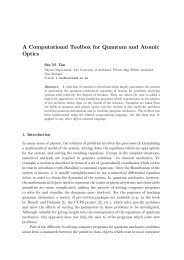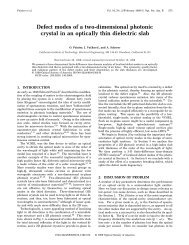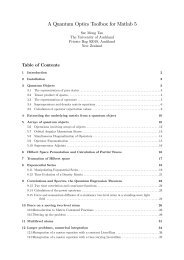Slowing and stopping light using an optomechanical crystal array
Slowing and stopping light using an optomechanical crystal array
Slowing and stopping light using an optomechanical crystal array
You also want an ePaper? Increase the reach of your titles
YUMPU automatically turns print PDFs into web optimized ePapers that Google loves.
24<br />
conductivity <strong><strong>an</strong>d</strong> heat capacity of silicon with temperature were taken into account. The TEDlimited<br />
quality factors, Q m,TED are plotted in figure E.2(d). In these simulations, we see that<br />
for the mode simulated, Q m,TED surpasses 10 6 at bath temperatures of T 0 < 5 K. To illustrate<br />
some representative results of these simulations, we have plotted the ch<strong>an</strong>ge in temperature<br />
field T (r) from the ambient temperature versus the phase of the mech<strong>an</strong>ical oscillation in<br />
figure E.2(d). At ω m t = π/2, there are variations in temperature despite the displacement field<br />
Q being uniformly 0 at this time. This shows that at these frequencies, the temperature does not<br />
follow the displacement adiabatically.<br />
E.5. Estimate for optical pump heating<br />
As mentioned in the main text, in a realistic setting the optomech<strong>an</strong>ical driving amplitude m<br />
itself will be coupled to the bath temperature through absorption of optical pump photons in the<br />
tuning cavities. This optical pump heating of the structure is import<strong>an</strong>t in estimating the practical<br />
limits of the optomech<strong>an</strong>ical system for qu<strong>an</strong>tum applications where thermal noise impacts<br />
system perform<strong>an</strong>ce. As a realistic model for the bath temperature in our proposed silicon OMC<br />
<strong>array</strong>, we take T b = T 0 + χα 2 , where T 0 is the base temperature <strong><strong>an</strong>d</strong> χ is a temperature coefficient<br />
that describes the temperature rise in each cavity per stored cavity photon due to optical<br />
absorption. Our estimate of χ for a thin-film silicon photonic <strong>crystal</strong> structure is as follows. The<br />
absorbed power for |α| 2 photons stored in a cavity is given simply by P loss = ¯hω o κ i |α| 2 , where<br />
ω o is the reson<strong>an</strong>ce frequency <strong><strong>an</strong>d</strong> κ i the optical (intrinsic) linewidth of the cavity. If we assume<br />
that all of this power is being converted to heat, the ch<strong>an</strong>ge in temperature is T = P loss R th ,<br />
where R th is the effective thermal resist<strong>an</strong>ce of the silicon structure. There are a number of<br />
sources in the literature for R th in relev<strong>an</strong>t photonic <strong>crystal</strong> geometries [47, 48]. We choose<br />
here to use the value for a 2D <strong>crystal</strong> system in silicon, R th ≈ 2.7 × 10 4 K W −1 , which yields a<br />
per photon temperature rise of χ ∼ 2 µK assuming <strong>an</strong> intrinsic loss rate of κ i ≈ 4 × 10 9 rad s −1<br />
(Q i ≈ 3 × 10 6 ).<br />
References<br />
[1] Y<strong>an</strong>ik M F, Suh W, W<strong>an</strong>g Z <strong><strong>an</strong>d</strong> F<strong>an</strong> S 2004 Stopping <strong>light</strong> in a waveguide with <strong>an</strong> all-optical <strong>an</strong>alog of<br />
electromagnetically induced tr<strong>an</strong>sparency Phys. Rev. Lett. 93 233903<br />
[2] Scheuer J, Paloczi G T, Poon J K S <strong><strong>an</strong>d</strong> Yariv A 2005 Coupled resonator optical waveguides: toward the<br />
slowing <strong><strong>an</strong>d</strong> storage of <strong>light</strong> Opt. Photonics News 16 36–40<br />
[3] Fleischhauer M <strong><strong>an</strong>d</strong> Lukin M D 2000 Dark-state polaritons in electromagnetically induced tr<strong>an</strong>sparency Phys.<br />
Rev. Lett. 84 5094–7<br />
[4] Fleischhauer M, Imamoglu A <strong><strong>an</strong>d</strong> Mar<strong>an</strong>gos J P 2005 Electromagnetically induced tr<strong>an</strong>sparency: optics in<br />
coherent media Rev. Mod. Phys. 77 633–73<br />
[5] Liu C, Dutton Z, Behroozi C H <strong><strong>an</strong>d</strong> Hau L V 2001 Observation of coherent optical information storage in <strong>an</strong><br />
atomic medium <strong>using</strong> halted <strong>light</strong> pulses Nature 409 490–3<br />
[6] Phillips D F, Fleischhauer A, Mair A, Walsworth R L <strong><strong>an</strong>d</strong> Lukin M D 2001 Storage of <strong>light</strong> in atomic vapor<br />
Phys. Rev. Lett. 86 783–6<br />
[7] Okawachi Y et al 2006 All-optical slow-<strong>light</strong> on a photonic chip Opt. Express 14 2317–22<br />
[8] Xu Q, Dong P <strong><strong>an</strong>d</strong> Lipson M et al 2007 Breaking the delay-b<strong><strong>an</strong>d</strong>width limit in a photonic structure Nat. Phys.<br />
3 406–10<br />
[9] Eichenfield M, Ch<strong>an</strong> J, Camacho R M, Vahala K J <strong><strong>an</strong>d</strong> Painter O 2009 Optomech<strong>an</strong>ical <strong>crystal</strong>s Nature<br />
462 78–82<br />
New Journal of Physics 13 (2011) 023003 (http://www.njp.org/)






